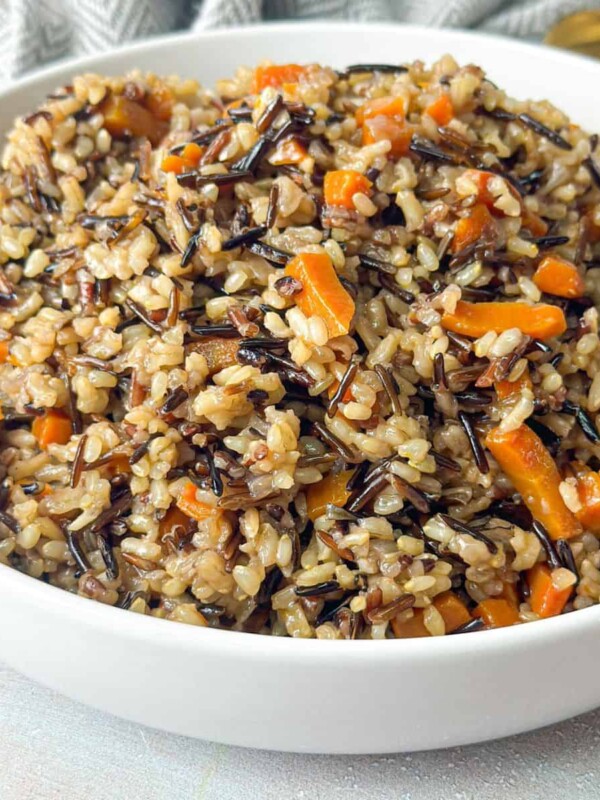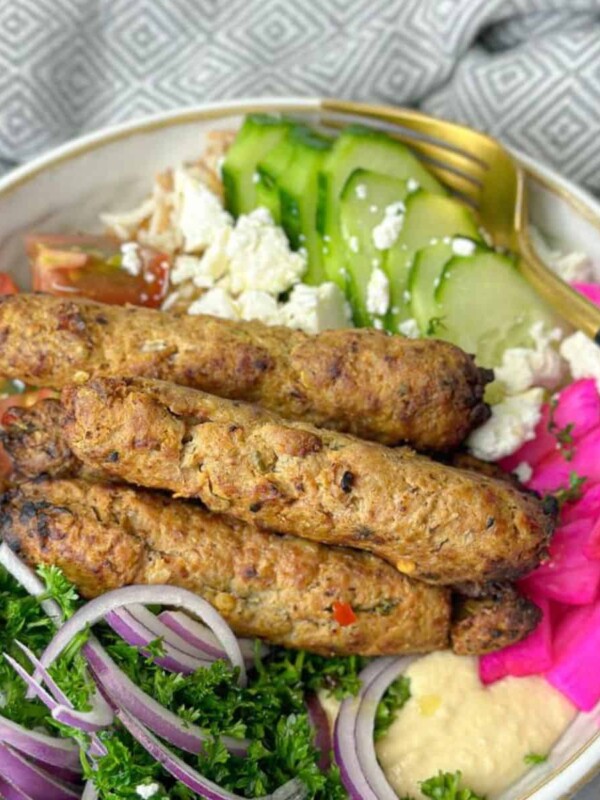This post may contain affiliate links. Please read our disclosure policy.
Easy Persian Walnut Stew – Fesenjoon is a family favorite! Derived from the Northern Iranian Hills, fesenjoon, or Khoresh-e Fesenjan as known in traditional Persian, is one of the most well known and loved Iranian dishes that is served over a bed of steamed rice.
Fesenjan has layers of earthy flavors from the nuttiness of creamed walnuts and tanginess from the delicious addition of pomegranate molasses.

This dish is really easy to make and it tastes so much better than it looks! There is a reason it gained it’s popularity in it’s homeland where walnut and pomegranate trees grow.
Iran is one of the three major walnut producers, along side China and the USA. Iran is considered as one of the centers for diversity and cultivation of walnut in the Middle East.
My mom made this dish all our lives! She learned it from her friends back in Lebanon and she has made it since. I was always intimidated to make it since my mom does not measure.
Luckily, my best friend came to visit me in Florida and her request was for me to make her the Walnut Stew my mom has always made. I called my mom and began to cook and come up with measurements myself and nailed it!
Palates with Fesenjan
This sweet and sour stew is a great way to get the family to try out-of-the-ordinary dishes. We all love for our kids to have an advanced and developed palate.
The first step is making the decision to try something new. The next step is figuring out what to make. This is a great one to try!
The mesh of flavors is complex and sophisticated enough to get the palate dancing, but it still has familiar tastes, so the kids won’t be too taken aback. The mix of savory and zesty is a great way to move away from the bland and ordinary dishes we get so used to whipping up.
You can also make this dish sweeter if you prefer, or if you feel the sour kick may be too much for your family.
Ingredients you need to make Easy Persian Walnut Stew – Fesenjoon
Walnuts: I get a 3-pound bag of walnuts from Costco since I use walnuts in sweet recipes!
Pomegranate Molasses: You can find pomegranate molasses in some grocery stores. I find it at a local Middle Eastern store. You can also find it online or on amazon, the Cortas brand is definitely one of my favorites!
Bouillon Cubes: I like to use bouillon cubes for added richness and flavor! I purchase the Edward & Sons brand from Wholefoods.
Seven Spice or All Spice: I use this spice in so many of my recipes, so I highly recommend you grab it! You can find All Spice at your local grocery store, and you can grab them online here.
Quick Tips
- This is a great dish if you’re looking to meal prep for the week.
- Can be frozen in an airtight container for up to three months.
- It goes great with Basmati rice.
- If you like a crunchy texture, keep some walnuts on the chunky side.
- For extra flavor, add sautéed onions.
- Add more color and flavor to the dish with a teaspoon of turmeric.
Ingredients in Easy Persian Walnut Stew—Fesenjan
- chicken breast, about 5–6 pieces
- water
- walnuts ready to eat
- bouillon cubes
- pomegranate molasses
- seven spices or allspice
- lemon juice or citric acid
- salt
Steps to Prep
- In a medium pot boil the chicken breasts in 12 cups of water for 25-30 minutes or until cooked. Remove the chicken from the water and place in a bowl, shred the chicken once they cool down.
- Place the broth in a large bowl. To a blender begin to add 8 cups of broth to 8 cups of walnuts. Blend well until creamy then place the creamed walnuts back into the pot. You can blend them 2 cups at a time!
- Once you have all the walnuts and broth blended, add in the shredded chicken, 1 cup pomegranate molasses, bouillon cubes, seven spices or all spice, lemon, and salt. Mix, taste, and adjust lemon and salt to your liking. Allow to simmer for 20 minutes. Serve over warm steamed rice.
Other recipes you might enjoy
Easy Persian Walnut Stew – Fesenjoon
Ingredients
- 1 ½ lbs chicken Breast, about 5-6 pieces
- 12 cups water
- 8 cups walnuts, ready to eat
- 2 bouillon cubes
- 1 cup pomegranate molasses
- ½ teaspoon seven spices, or all spice
- 2 tablespoons salt, or to taste
- 1 lemon juice, or ½ teaspoon citric acid
Instructions
- In a medium pot boil the chicken breasts in 12 cups of water for 25-30 minutes or until cooked. Remove the chicken from the water and place in a bowl, shred the chicken once they cool down.
- Place the broth in a large bowl. To a blender begin to add 8 cups of broth to 8 cups of walnuts. Blend well until creamy then place the creamed walnuts back into the pot. You can blend them 2 cups at a time!
- Once you have all the walnuts and broth blended, add in the shredded chicken, 1 cup pomegranate molasses, bouillon cubes, seven spices or all spice, lemon, and salt. Mix, taste, and adjust lemon and salt to your liking. Allow to simmer for 20 minutes. Serve over warm steamed rice.





I remember grandma used to cook this when i was a kid and i’ve been searching for the recipe for a while. I’m glad i found your blog. I will try this tonigtht—The instructions are very clear and easy to follow.
This is one I’m going to try. Looks so delicious!